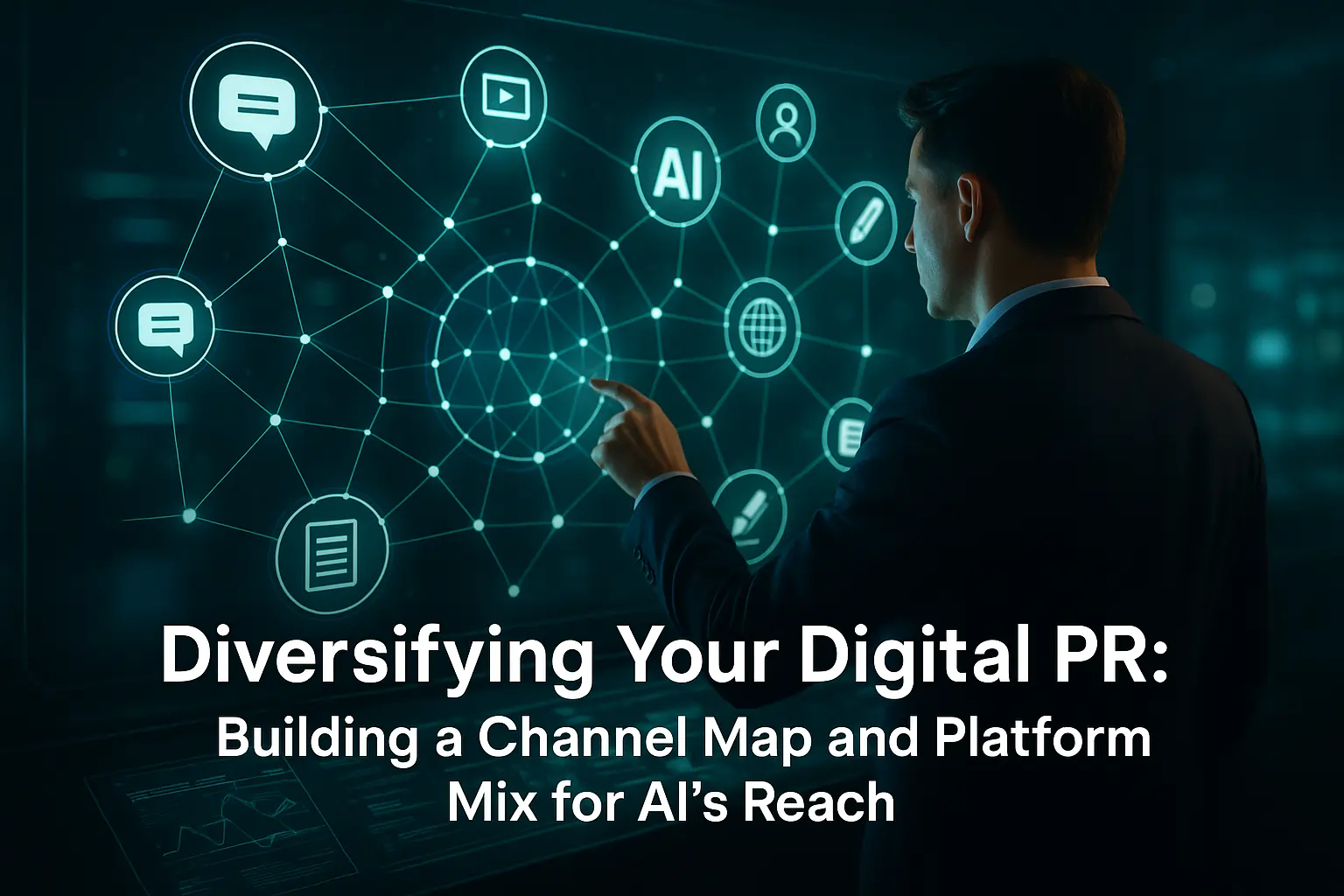Diversifying Your Digital PR: Building a Channel Map and Platform Mix for AI's Reach

The world of digital public relations is undergoing a seismic shift. For years, the goal was simple: get your brand featured in a top-tier journal and watch the credibility roll in. But today, your audience isn't just human anymore. A new, powerful reader is scanning everything: the artificial intelligence that powers Google's AI Overviews, ChatGPT, and other answer engines.
Relying on a few big media wins is now a dangerously outdated strategy. AI doesn't just read the news; it synthesizes information from a vast and varied digital ecosystem to decide who is a proper authority. If your brand’s voice is only heard in a few isolated corners of the internet, you risk being invisible to this new gatekeeper of information. To win in this new landscape, businesses in Hyderabad and across India need a more sophisticated, diversified approach. It’s time to build a strategic channel map—a crucial component of a modern Generative Engine Optimization (GEO) plan that ensures you’re not just part of the news, but part of the answer.
Why Your Old Digital PR Strategy Is Failing in the Age of AI
Think of an AI search engine as a meticulous researcher. When asked a question, it doesn't just grab the first impact it sees. Instead, it scans news articles, blog posts, industry forums, social media discussions, and user reviews to form a comprehensive answer. It’s looking for "credibility by consensus."
AI models build trust in a brand when they see it mentioned consistently and positively across many different, credible platforms. This is the fundamental flaw in a narrow PR strategy. A single feature in a major newspaper is a great start, but it's just one data point for an AI. If your competitors are being discussed on LinkedIn, quoted in niche blogs, and recommended on Reddit, the AI will likely perceive them as a more established authority and cite them in its generated answers.
The risk is severe but straightforward: if your brand’s expertise isn't distributed across a wide range of channels, you will be invisible to the very systems that are quickly becoming the primary source of information for your customers.
Introducing the Channel Map: Your Blueprint for AI Visibility
A channel map is a strategic document that identifies, categorizes, and prioritizes all the digital platforms and touchpoints where you can build your brand's power for both human and AI audiences. It’s not about being everywhere at once; it’s about being in the right places consistently.
The purpose of a channel map is to move beyond one-off placements and instead create a vast, interconnected web of expert content, positive mentions, and authentic engagement. It’s about strategically leaving "breadcrumbs across the internet" that AI crawlers can easily find, connect, and use to validate your brand as a trusted source.
The 5 Core Pillars of a GEO-Ready Channel Map
To build a robust digital presence that AI will recognize, your channel map should be built on five different pillars, each playing a unique role in establishing authority.
Pillar 1: High-Authority Earned Media
This is the traditional heart of PR: securing placements in top-tier, respected publications. Think major news outlets, leading industry journals, and influential business magazines.
- Why it matters for AI: These outlets are foundational trust signals. AI models are trained to recognize these sources as highly authoritative, and a mention here gives your brand instant credibility.
Pillar 2: Owned Media & Content Hubs
This pillar includes your own digital properties: your company website, blog, and online newsroom. This is your home base, where you have complete control over the narrative.
- Why it matters for AI: This is where you prove your deep, comprehensive expertise. By building content hubs using a pillar-and-cluster model, you can demonstrate a structured, in-depth knowledge of a topic, a format that AI algorithms find highly valuable when sourcing information.
Pillar 3: Social & Community Platforms
This category covers platforms built on user interaction and conversation. This includes LinkedIn for B2B thought leadership, industry-specific forums, and Q&A sites like Quora and Reddit.
- Why it matters for AI: AI looks to these platforms for authentic, real-world conversations and user sentiment. It wants to understand what real people are saying about your enterprise and your brand, making your presence here a powerful signal of relevance.
Pillar 4: Collaborative & Influencer Media
This involves leveraging the voices of others. This includes partnerships with niche micro-influencers, guest appearances on popular podcasts, and collaborative content with non-competing brands.
- Why it matters for AI: This provides crucial third-party validation. When a respected influencer or industry expert mentions your brand, it serves as a strong endorsement that AI can easily recognize.
Pillar 5: Multimedia Platforms
This pillar concentrates on non-text formats like video, audio, and rich visuals. Think YouTube channels, podcast series, webinars, and detailed infographics.
- Why it matters for AI: AI is increasingly multi-modal, meaning it can understand and process images, video, and audio. Creating high-quality multimedia content gives you more diverse ways to be found and cited in visually rich AI-generated answers.
How to Build Your Custom Platform Mix in 4 Steps
With the five pillars as your guide, you can now build a tailored platform mix that aligns with your specific industry needs.
Step 1: Define Your Goals and Audience
Before choosing any channels, you must know who you're trying to reach and what you want to achieve. Start by setting SMART (Specific, Measurable, Achievable, Relevant, Time-bound) goals. Then, build detailed buyer personas. Where does your ideal Hyderabad-based customer get their information? What are their biggest challenges? Which social platforms do they trust?.
Step 2: Select Your Channels Strategically
You cannot be everywhere. Based on your audience research, choose a strategic mix of channels from the five pillars that offers the highest potential for impact. If you’re a B2B tech firm in Hyderabad, your mix might lean heavily on LinkedIn, high-authority tech blogs, and industry podcasts. A consumer brand, on the other hand, might prioritize Instagram, YouTube, and collaborations with local influencers.
Step 3: Tailor Your Content for Each Platform
A single message requires different packaging for different channels. Your core story of expertise should remain consistent, but the design must adapt.
- For LinkedIn: Share professional insights and in-depth articles.
- For your Blog: Publish comprehensive, data-driven guides and case studies.
- For Instagram/YouTube: Create engaging short-form videos and visual tutorials.
Step 4: Measure, Analyze, and Optimize
Digital PR is not a "set it and forget it" activity. Use modern AI visibility tracking tools to monitor how often your brand is being mentioned in AI answers and which channels are pushing those citations. If you notice that your guest appearances on podcasts are leading to more AI mentions than your press releases, it’s time to adjust your resource allocation and double down on what works.
A Masterclass in Multi-Channel Dominance: The CeraVe Case Study
For a real-world example of a diversified channel strategy in action, look no further than the skincare brand CeraVe. They orchestrated a brilliant campaign built around a fake conspiracy that actor Michael Cera was the company's founder.
This narrative didn't just live in a single press release or TV ad. It was a story that unfolded dynamically across a vast channel map:
- Influencers and Social Media: The campaign started with "leaked" sightings from influencers showing Michael Cera with the products.
- Collaborative Media: It escalated with a staged, awkward interview on a popular podcast.
- Owned and Earned Media: CeraVe's official channels and dermatologist partners playfully "fought back" against the rumors, generating thousands of articles and dominating the online conversation.
The campaign culminated in a Super Bowl ad that served as the final punchline. By building a massive, multi-platform conversation, CeraVe made themselves impossible for anyone—human or AI—to ignore. They didn't just buy an ad; they owned the real narrative across a masterfully executed channel map.
Conclusion: Your Future-Proof PR Strategy Starts Now
The rise of AI search is not a distant threat; it is a present-day reality that demands an immediate evolution in our approach to digital PR. Siloed tactics and a narrow focus on traditional media are no longer enough to guarantee visibility.
Success in this new era belongs to labels that think like an AI—brands that build a broad, deep, and interconnected web of authority across multiple platforms. Your channel map is the blueprint for this new reality. By strategically diversifying your actuality across earned, owned, social, collaborative, and multimedia platforms, you create a powerful, unified signal of expertise that both your customers and the AI engines they use will trust. This is the core of a successful GEO plan and the key to securing your brand's relevance for years to come.
Share
Table Of Contents
- Why Your Old Digital PR Strategy Is Failing in the Age of AI
- Introducing the Channel Map: Your Blueprint for AI Visibility
- The 5 Core Pillars of a GEO-Ready Channel Map
- How to Build Your Custom Platform Mix in 4 Steps
- A Masterclass in Multi-Channel Dominance: The CeraVe Case Study
- Conclusion: Your Future-Proof PR Strategy Starts Now
